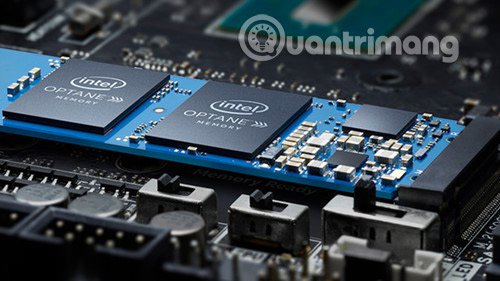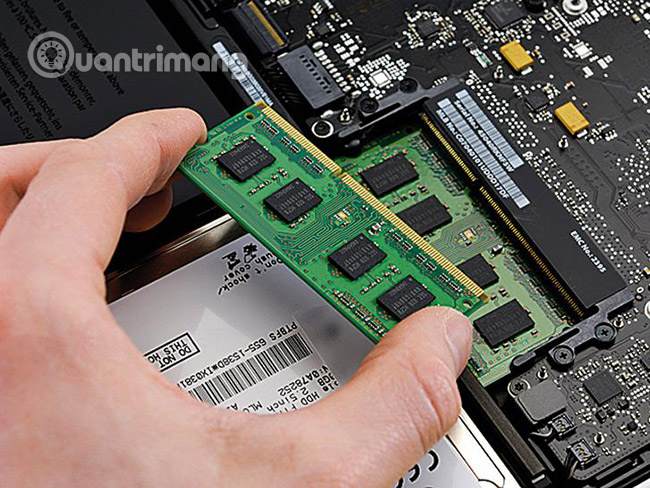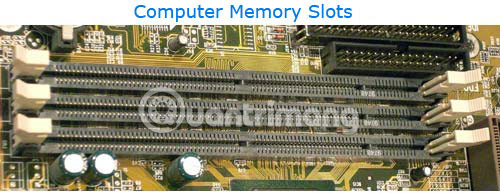How to determine if computer memory has a problem?
A bad memory can cause a lot of different problems on the computer. Here are just a few of the many problems you may encounter. The important thing to remember is that the following problems may not only stem from problematic memory causes.
1. The computer does not start, and you receive a beep code. Please refer to the article: How to diagnose a computer error through a beep for more details.
2. Computer problems randomly cause errors such as BSOD (dead blue screen error), error General Protection Fault, Illegal Operations, Fatal Exceptions, etc.
3. Restart the computer randomly.
4. Program installation errors or other Windows errors.
Note before checking memory : If you recently added any new memory to your computer, you should temporarily remove that memory to ensure the new memory is not the cause of the problem. friend.
Is computer memory problematic?
- Testing by software
- Swap and remove memory
- Replace memory
- Tips for buying computer memory
- What kind of memory does the computer need?
- Before buying memory
- How much memory should you have?
- What should you expect?
Testing by software
There are several software programs available, designed to test computer hardware, including computer memory:
- Windows Vista, Windows 7, and Windows 10 have the Windows Memory Diagnostics Tool ( Windows Memory Diagnostic Tool ). This tool is accessible by clicking Start Orb and entering "memory" in the run line. Running this command will open the Windows Memory Diagnostics Tool with two options: " Restart now and check for problems " or " Check for problems the next time I start my computer ". Selecting one of these options will run the computer memory check feature on the next boot.
- Memtest86 - Today's proposal to test computer memory errors, Memtest86, is a compatible, free x86 memory testing tool.
- DocMemory - Another great software solution to check the status of your computer memory. (Link download: http://www.auyanet.net/?p=17471)
Here is a list of some other great products you can refer to.
- Memorytesters.com - Companies offering different hardware solutions to check computer memory. These are the highest quality methods for memory testing, but are likely to be used only at a computer service center because of the high cost.
- PC-doctor.com - A great, but slightly expensive solution, often used by service centers and technicians to diagnose computer hardware problems, including memory problems .
- PC-diagnostics.com - A company that provides both hardware and software solutions to test most computer hardware, including memory.
- Ultra-X (uxd.com) - A great collection of products that can help test computer hardware, including memory.

Swap and remove memory
If you have access to compatible memory from another computer, you can swap that memory into your computer, to see if it is the cause of the problem. Using alternative memory in a computer may be having memory problems is an effective test method.
If your memory is still working normally on another computer without any problems, you may encounter problems with the motherboard, PSU or another hardware problem.
Replace memory
If you have determined that your computer memory has problems, the best advice now is that you should replace the old memory with a new memory. You can find additional information and tips on buying computer memory in the next section of the article.
Tips for buying computer memory
As mentioned above, computer memory is one of the most commonly purchased and replaced details. Here is a list of things to consider and some different tips when choosing to buy computer memory.
What kind of memory does the computer need?
Determine the type of memory needed
Until now, the best way to determine which memory should be used with a computer is through the computer manufacturer's or motherboard's documentation. If you do not have documentation about your product, you can also find documentation online through the computer manufacturer website or motherboard manufacturer website.
For example, the features in the motherboard documentation may list the same information as the example below:
- DDR 400/333/266 SDRAM support.
- Supports up to 3 DIMM or DDR SDRAM 2.5 volt.
- Up to 1GB for each DIMM with a maximum memory capacity of up to 3GB.
In the example above, you can see that this motherboard supports DDR SDRAM DIMM at speeds of 400, 333 and 266.
Use third party tools or services
Another option is to use a third-party software utility or an online service that can provide details about the components in the computer. These utilities can scan your computer and provide a detailed report of everything in your computer, including memory. For example, Crucial System Scanner (http://www.crucial.com) is a free utility that can scan your computer, and provide you with detailed information about installed memory, as well as any Any memory slot available.
Check external memory

Finally, you can also open the computer. Take ESD precautions (electrostatic discharge), remove one of the memory sticks and check the physical to find any identification labels or printed labels.
What to look for in memory
Below is a short list of what you should look for or determine when trying to check the memory your computer is using.
Memory type
What type of memory does the computer use? Some examples of different types of memory include DDR-SDRAM, DDR2-SDRAM, DIMM, DRAM, EDO, FPM, SDRAM, LIMM, RDRAM (RAMBUS), RIMM, SIMM and SODIMM. Today's computers often use a variant of DIMM / SDRAM memory.
Number of batteries
How much battery does the computer accept? 72, 30, 168, 184 or 240 batteries? All this depends on the type of memory.
Memory speed
There are two main measurements of memory speed.
- The "speed" of memory usually refers to the number of times the memory can read or change its data every second. This speed is measured in MHz and strongly affects the overall performance of the CPU.
- Latency is a time (very short) for memory to respond to information, access data stored in memory and send that data to the CPU. Latency is measured in nanoseconds (ns).
Although latency is an important metric, the difference in relatively small latency in compatible RAM modules. When making decisions about the memory used in your computer, the speed measured in MHz is often a more important number to consider.
Note : If you install more memory at different speeds in the computer, lower speed memory will be used and you will not get potential benefits from the module faster. Whenever possible, use RAM modules of similar speed. Ideally all the RAM you install should be identical.
Error checking
ECC (error-correcting code) is used in professional servers and workstations. It sacrifices speed benefits to provide protection, as well as a quick check to make sure there are no errors when the data is modified in RAM.

Errors can occur naturally in RAM due to electromagnetic interference or hardware failure. As a result, bits can be "overturned" in RAM: Some 1 bits are set to 0 or vice versa. These errors usually do not damage normal applications like games or web browsing. (If a pixel in the video game background is wrong, then you may not notice or care about it.) However, for professional applications that require high accuracy, such as financial transactions or scientific calculations, ECC is an essential feature. ECC does not completely prevent errors, but it reduces their ability to occur near zero.
Not all motherboards support ECC and motherboards that support ECC are often more expensive. ECC RAM modules are also more expensive than RAM without ECC at the same speed. If you are not sure you need ECC, you may not need to pay extra for this feature. Building a computer without ECC support is often a wise investment, in terms of performance.
Voltage
What are the voltage requirements? Make sure you specify the memory voltage requirements (eg 1.8v or 2.5v).
Contact material
Exposure materials are a very important factor when considering buying computer memory. The contact area is covered with gold or tin and must match the material of the memory slot. Materials that do not match the memory and contact slot of the memory may cause corrosion.
Monopoly
Finally, is the memory in your computer exclusive, and if not, what is the manufacturer's name? If you have a recently purchased computer (in the last 5 years), congratulations, you don't need to care about this.
Before buying memory
Make sure the computer has available memory slots for the memory you are about to install. For example, if you are installing 1GB of additional memory into your computer and planning to use two 512MB memory cards, make sure you have two available slots. If you do not have an available slot, you may have to remove the existing memory and install new memory. However, any memory removed will affect your total memory. Below is an example of a possible situation.

A computer has 512MB of memory, from 4 different 128MB RAM and no other slots. If you want to upgrade to a total of 1GB, 4 128MB bars will need to be replaced with 4 256 MB bars. Or, or two of 4 128MB bars can be replaced with two 512MB bars. (1GB = 1024 MB)
How much memory should you have?
This question depends on you, the program you plan to run on the computer and the number of programs you open at a given time. One of the best methods to determine the amount of RAM you need is to review the system requirements of the programs you are running on your computer and double any memory requirements for the program you use. Most. However, below is a general recommendation for the memory that a computer should have for today's programs and operating systems.
- Minimum: 2GB
- Recommendation: 8GB
- Excellent: 8GB or more.
What should you expect?
Upgrading memory for computer systems may have the following benefits:
- Allow programs to require more memory.
- Help computer or computer program increase load speed and opening time.
- Fix memory errors.
See more:
- 5 ways to check hard drive effectively to help periodically check the hard drive
- 7 leading hardware error diagnosis tools for Windows 10
- How many reasons does Windows not receive enough RAM?
 Fix the error 'Windows Cannot Be Installed to a Disk'
Fix the error 'Windows Cannot Be Installed to a Disk' How to create a USB toolkit to solve any computer problem
How to create a USB toolkit to solve any computer problem Summary of common VPN error codes
Summary of common VPN error codes 5 ways to enter the Windows 10 key the easiest
5 ways to enter the Windows 10 key the easiest Ways to fix BSOD blue screen error
Ways to fix BSOD blue screen error How to fix 408 Request Timeout error
How to fix 408 Request Timeout error